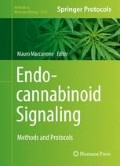Abstract
Measuring the functional behavior of G protein-coupled receptors (GPCRs) has been a major focus of academic and pharmaceutical research for many decades. These efforts have led to the development of many assays to measure the downstream effects of ligand binding on receptor activity. In this chapter, we describe an internalization/recycling assay that can be used to track changes in receptor number at the plasma membrane. Used in concert with other assays, this antibody-based technique can provide important information on GPCR activation by receptor-specific ligands.
Access this chapter
Tax calculation will be finalised at checkout
Purchases are for personal use only
References
Drake MT, Shenoy SK, Lefkowitz RJ (2006) Trafficking of G protein-coupled receptors. Circ Res 99:570–582
Petrov RR, Knight L, Chen SR et al (2013) Mastering tricyclic ring systems for desirable functional cannabinoid activity. Eur J Med Chem 69:881–907
Atwood BK, Wager-Miller J, Haskins C et al (2012) Functional selectivity in CB(2) cannabinoid receptor signaling and regulation: implications for the therapeutic potential of CB(2) ligands. Mol Pharmacol 81:250–263
Atwood BK, Huffman J, Straiker A et al (2010) JWH018, a common constituent of ‘Spice’ herbal blends, is a potent and efficacious cannabinoid CB receptor agonist. Br J Pharmacol 160:585–593
Daigle TL, Kearn CS, Mackie K (2008) Rapid CB1 cannabinoid receptor desensitization defines the time course of ERK1/2 MAP kinase signaling. Neuropharmacology 54:36–44
Coutts AA, Anavi-Goffer S, Ross RA et al (2001) Agonist-induced internalization and trafficking of cannabinoid CB1 receptors in hippocampal neurons. J Neurosci 21:2425–2433
Roche JP, Bounds S, Brown S et al (1999) A mutation in the second transmembrane region of the CB1 receptor selectively disrupts G protein signaling and prevents receptor internalization. Mol Pharmacol 56:611–618
Hsieh C, Brown S, Derleth C et al (1999) Internalization and recycling of the CB1 cannabinoid receptor. J Neurochem 73:493–501
Jin W, Brown S, Roche JP et al (1999) Distinct domains of the CB1 cannabinoid receptor mediate desensitization and internalization. J Neurosci 19:3773–3780
Luttrell LM, Ferguson SS, Daaka Y et al (1999) Beta-arrestin-dependent formation of beta2 adrenergic receptor-Src protein kinase complexes. Science 283:655–661
Miller WE, Lefkowitz RJ (2001) Expanding roles for beta-arrestins as scaffolds and adapters in GPCR signaling and trafficking. Curr Opin Cell Biol 13:139–145
Wang Q, Lu R, Zhao J et al (2006) Arrestin serves as a molecular switch, linking endogenous alpha2-adrenergic receptor to SRC-dependent, but not SRC-independent, ERK activation. J Biol Chem 281:25948–25955
Mikasova L, Groc L, Choquet D et al (2008) Altered surface trafficking of presynaptic cannabinoid type 1 receptor in and out synaptic terminals parallels receptor desensitization. Proc Natl Acad Sci U S A 105:18596–18601
Daigle TL, Kwok ML, Mackie K (2008) Regulation of CB1 cannabinoid receptor internalization by a promiscuous phosphorylation-dependent mechanism. J Neurochem 106:70–82
Zhang JH, Chung TD, Oldenburg KR (1999) A simple statistical parameter for use in evaluation and validation of high throughput screening assays. J Biomol Screen 4:67–73
Acknowledgements
Supported by National Institutes of Health (grants DA011322 and DA021696).
Author information
Authors and Affiliations
Corresponding author
Editor information
Editors and Affiliations
Rights and permissions
Copyright information
© 2016 Springer Science+Business Media New York
About this protocol
Cite this protocol
Wager-Miller, J., Mackie, K. (2016). Quantitation of Plasma Membrane (G Protein-Coupled) Receptor Trafficking in Cultured Cells. In: Maccarrone, M. (eds) Endocannabinoid Signaling. Methods in Molecular Biology, vol 1412. Humana Press, New York, NY. https://doi.org/10.1007/978-1-4939-3539-0_26
Download citation
DOI: https://doi.org/10.1007/978-1-4939-3539-0_26
Published:
Publisher Name: Humana Press, New York, NY
Print ISBN: 978-1-4939-3537-6
Online ISBN: 978-1-4939-3539-0
eBook Packages: Springer Protocols

